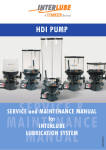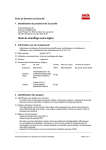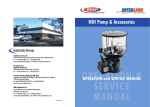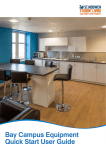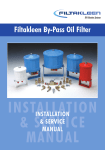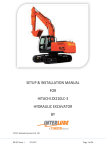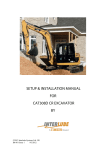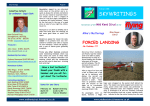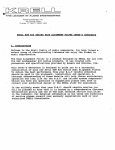Download INSTALLATION MANUAL
Transcript
Multi-Line Systems INSTALLATION INSTALLATION MANUAL MANUAL Index This Publication covers the fitting and connecting of Interlube’s range of Multi-Line Automatic Chassis Lubrication Systems AC SERIES INTRODUCTION FOR MORE INFORMATION ON PUMP OPERATION AND SPARES PLEASE REFER TO MULTI-LINE OPERATION AND MAINTENANCE GUIDE. DO’S AND DON’TS Health & Safety at Work Act 1974 DO’S AND DON’TS Do’s 1. General System Description Do read all instructions before commencing installation. 2. Planning The System Do observe safety regulations regarding operating the vehicle in confined spaces. 3. Preparing The Pump Do take precautions to keep all components in the system clean. 4. Siting/Mounting The Pump Do use existing holes in chassis for mounting where possible. 5. Making the Looms Don’ts 6. Fitting The Looms Don’t drill any holes in chassis flanges. 7. Connecting The Looms Don’t drill holes through any part of the vehicle until you have checked the area is free of electric cables and pipe work. 8. Eletrical Connections Don’t drill a series of holes that may cause a weakening of the chassis. 9. Testing The System Don’t attach Interlube pipe work to the existing pipes that are subject to heat, e.g. the outlet pipe from the vehicle air compressor etc. 10.Timer Adjustment 11.Accessories Don’t work underneath raised body without full body props in place. SAFETY PRECAUTIONS (Health and Safety at work Act 1974) UK Headquarters: Interlube Systems Ltd St Modwen Road, Parkway Industrial Estate, Plymouth, Devon, England PL6 8LH Tel: +44 (0)1752 676000 Fax: +44 (0)1752 676001 e-mail: [email protected] Web Site: www.interlubesystems.com Never direct High Pressure Air, Grease or Oil Delivery Nozzles at any part of the body. Always switch off and remove the fuse from the electrical supplies, uncouple pressure supplies before commencing any maintenance work. Make sure that any guards or covers removed for maintenance work are replaced before operating the equipment. USA Headquarters: Interlube Systems Inc 4696 Wadsworth Road, Dayton, Ohio, 45414, USA Tel: + 1 937 276 4507 Fax: + 1 937 276 4518 e-mail: [email protected] 1 1. GENERAL SYSTEM DESCRIPTION 3. PREPARING THE PUMP The Interlube AC range has been designed to provide reliable and virtually maintenance free service in the most demanding applications. The system comprises an electrically operated 12/24 V pump with integral controller, and a loom of tubing which connects each chassis bearing directly to its own respective pumping unit. Each bearing is fed independently, meaning that points can be individually calibrated, and also damage to one line does not affect the rest of the system. The pumps come in two variations; the AC1 and AC2 (fig 2) which have 1 & 2 litre top fill reservoirs and have the motor and controller housed in the lid, and the AC3 (fig 1) which has a 3 litre reservoir and has the motor and controller housed in the pump base. The motor drives the impellor, which draws grease into the pumping chamber and also gives a visual indication of cam rotation. It also drives the cam, which operates the individual pumping units, and feeds grease into the tubing. The pumps can operate with a wide range of lubricants from SAE 80 oil up to and including NLGI grade 2 grease. Fit the pumping units into the carcass ring of the pump, taking care not to over tighten. Where spare positions occur, use blank plugs. It is recommended that where possible pumping units are spaced symmetrically around the pump and not grouped together in one area. PUMPING UNITS Each chassis bearing requires a measured volume of lubricant, determined by size and function. To meet this requirement INTERLUBE provides a range of six pumping units, with the outputs shown below, colour coded for easy identification during instalation, and with push-in type tubing cartridge. Red 0.010 cc ...............................78033 Green 0.015 cc ...............................78034 Yellow 0.025 cc ...............................78035 Blue 0.040 cc ...............................78036 Grey 0.060 cc ...............................78037 Black 0.100 cc ...............................78038 Blanking Plug .............................................34237-402 2. PLANNING THE SYSTEM 1. Tilt cab (where applicable). 2. Flush out all bearings to be connected to the system and clean all bearing surfaces. 3. Remove grease nipples and insert connectors to establish number of bearings to be lubricated. 4. Prepare specification sheet by listing bearings to be connected and referring to the calibration chart to determine pumping unit output recommendation. Manual Over-Ride Button FIG 2 • FIG 1 • • Quick-Fill Connector • • Manual Over-ride Button Filling Point for Oil/Soft Grease • Timing Adjustment 2 Filling Adaptor for Heavy Grease 4. SITING/MOUNTING THE PUMP FIG 3 Select a suitable mounting point for the pump on main chassis in a position where it is protected from debris thrown up by the wheels. Ensure adequate clearance for reservoir top-up to be achieved. Do not mount the pump onto ancillary equipment (i.e. battery covers etc). Using the adhesive template supplied, position and drill the bracket mounting holes as shown in figs 5 & 6 (see Do’s and Don’ts page 1). Using the spring washers and screw/nuts secure the pump in position. AC3 (3 litre Reservoir) Maximum 60 Lubrication Points. For more than 60 points please contact Interlube. Operates for up to 2000 hours on each reservoir filling. FIG 4 AC2 (2 litre Reservoir) Maximum 36 Lubrication Points. Operates for up to 1500 hours on each reservoir filling. FIG 5 FIG 6 AC1 & AC2 AC3 CALIBRATION CHART 1. 2. 3. 4. 5. 6. 7. 8. 9. 10. 11. Typical Multi-line Chassis Layout Pumping Unit Power Steering Cylinder Front Power Steering Cylinder Intermediate Power Steering Cylinder Rear Track Rod End Shackle Pins Front Clutch operating Shaft (Split Feed* - see note) Spring Pins Shackle Pins Rear Brake Cam Shaft Front King Pins Brake Cam Shaft Rear *Split Feeds are only permitted on oil lubrication systems. Grease Systems TypicaI Bearing Chart 0.025 0.025 0.025 0.040 0.040 0.015 0.025 0.040 0.015 0.040 0.015 MULTI-LINE EXPLODED VIEW TYPICAL MULTI-LINE CHASSIS LAYOUT Other Bearings usually connected to the lubrication system: Balance Beam Bearings (2 feeds) Drag Link Ball Joint Gear Lever Linkage Accelerator Cross Shaft Pedal Linkages Brake Slack Adjusters Tipping Body Hinges Fifth Wheel Coupling Pivot Point Fifth Wheel Coupling Jaws 2 x 0.040 0.040 0.015 0.015 0.015 0.025 0.025 0.025 0.025 Y Z 3 Pump Ignition Controlled Electrical Supply 5. MAKING THE LOOMS 7. CONNECTING THE LOOMS The loom should be formed using Interlube 4mm semi-rigid nylon tubing. It is recommended that grease filled tube is used so that the system does not have to be primed prior to operation. From the pump position ascertain the most convenient favourable route for the looms. The number of looms required will depend on pump location and quantity and positioning of grease points. Using looming stands if available, form individual tubes into a loom allowing sufficient length for connection to pump and bearings and allowing for chassis movements (e.g. springs, steering, lifts etc). In conjunction with the installation record sheet fit number identification sleeves to tubing at pump and bearing ends. The loom should be protected along its length with the conduit/spiral binding/sleeving, and/or tape (for part numbers see section 11 Accessories) The loom can consist of tubes of varying lengths which can leave the loom at the required point (fig 7). Cut each tube to length ensuring a clean square cut is achieved, and connect to bearing using push fit connectors. ENSURE TUBING IS PUSHED FIRMLY INTO CONNECTOR. TEST ASSEMBLY BY PULLING FIRMLY ON THE TUBE. Using System Specification Sheet connect the loom to corresponding numbered pumping units. When running the tubing into the pumping units, to give the loom strength and rigidity, the tubes should be clipped together to form an arrangement as shown in fig (8) below. The starting point for the loom can be as required. On the underside of the AC2 a mark indicates a suggested starting point. Starting with the bottom row of outlets, and pumping unit 1, the loom should then run right around the pump, then on to connect with the next row of pumping units so that the loom takes the form of a spiral, and so on until all pumping units are connected. Alternatively the pump units in all rows can be connected by working around the pump ring, but the loom should still be formed as per fig 8. Alternatively the loom can be run in the opposite direction. Approximate distance of the loom from pump should be approx 60mm. Tubes should be clipped together every 6 pump units. The loom/looms can then be routed on to the chassis as required. 6. FITTING THE LOOMS Working from the furthest point from the pump, feed the loom through the chassis following existing vehicle services where possible (see do’s and don’ts page 1). Ensure tubes are positioned to fit bearing connectors. Where bearing is on a moving part, ensure tube length is sufficient to allow for full movement. To avoid rubbing or friction with chassis, grommets or protective sleeving should be used. FIG 8 60 Loom Direction FIG 7 Protective sleeving Half Lapped Tape Loom stand Sufficient length of tube to reach bearing points Loom stand Pinch a tab of tape across the end of the tube to secure the I.D. No. 2 4 3 Typical Loom Stand 4 5 FIG 9 8. ELECTRICAL CONNECTIONS Connect the twin core cable via an in line fuse (2Amin/5A max) to an ignition controlled circuit. See figures 9 & 10. INSTALLATION DIAGRAM AC1 & AC2 9. TESTING THE SYSTEM With the ignition ON, check that the indicator light is illuminated (see figures 11 & 12). Operate the manual override button, and check for paddle rotation. The indictor light should flash slowly. NB. Should the motor fail, it will be indicated by a fast flash. 10. TIMER ADJUSTMENT AC1 / AC2 The pump cycle time can be changed from the factory set option if required. There are four settings as listed below and show the cycle time including 2.5min run time and delay period. The rotary timer is on the PCB which is inside the motor housing. This is accessed by removing the lid, and opening the motor housing. FIG 10 INSTALLATION DIAGRAM AC3 The switch positions are:0- Continuous (2.5 min cycle time) 1- 9 minutes cycle time 2- 12 minutes cycle time 3- 15 minutes cycle time AC3 The pump is available with 10 settings with the delay timing control via a rotary switch located behind a screw cap at the front of the motor housing. The motor runs for 1 minute and 8 seconds. Switch positions:0 – continuous double speed (1.8 RPM) 1 – continuous at normal speed (0.9RPM) normal trailer applications. 2 – 3 minute delay (4 minute total cycle time) 3 – 7 minute delay (8 minute total cycle time) 4 – 11 minute delay (12 minute total cycle time) 5 – 15 minute delay (16 minute total cycle time) 6 – 19 minute delay (20 minute total cycle time) 7 – 24 minute delay (25 minute total cycle time) 8 – 30 minute delay (31 minute total cycle time) 9 – 36 minute delay (37 minute total cycle time) FIG 11 FIG 11 FIG 12 Manual Override button • Indication Light • • • Indication Light FIG 12 5 Manual Override button LOOMING ACCESSORIES 11. ACCESSORIES Plastic tape 1” Black . . . . . . . . . . . . . . . . . 1755-830 Spiral Binding (1-2 lines). . . . . . . . . . . . . . 1837-001 Spiral Binding 8mm I/D (3-4 lines) . . . . . . 1837-002 Spiral Binding 10mm I/D (5-7 lines) . . . . . 1837-003 Spiral Binding 14mm I/D (8-12 lines) . . . . 1837-004 Conduit 7mm diameter. . . . . . . . . . . . . . . . 27315-707 Conduit 10mm diameter. . . . . . . . . . . . . . . 27315-710 Conduit 12mm diameter. . . . . . . . . . . . . . . 27315-712 Conduit 17mm diameter. . . . . . . . . . . . . . . 27315-717 Split Conduit 7mm diameter . . . . . . . . . . . . 27315-907 Split Conduit 10mm diameter . . . . . . . . . . . 27315-910 Split Conduit 12mm diameter . . . . . . . . . . . 27315-912 Split Conduit 17mm diameter . . . . . . . . . . . 27315-917 ELBOW CONNECTORS GREASE Premium Grade NGLI 000 / FG3,0 25717-284 Bottles 25717-284 / 12.5K 25717-284 / 25K 25717-284 / 50K 25717-284 / 180K STRAIGHT CONNECTORS 12 x 1 Litre 12.5 KG Pail 25 KG Pail 50 KG Pail 180 KG Pail NLGI Grade 2 25717-270 / 12.5K 25717-270 / 25K 12.5 KG Pail 25 KG Pail GREASE SPECIFICATIONS NGLI 000 / FG3,0 Colour .....................................................Amber Texture.....................................................Fluid, Tacky NLGI........................................................000 Soap Type ...............................................Calcium Penetration @ 25°C.................................445-475 Base Viscosity @ 40°C ...........................35 to 45 CST Drop Point ...............................................N/A ACCESSORIES 152823/25 .........4mm OD soft grease filled tube x 25M 152823/50 .........4mm OD soft grease filled tube x 50M 152821/25 .........4mm OD Heavy grease filled tube x 25M 27233-507 .........Cable ties OA50397/1 OA50397/2 OA50397/3 OA50397/4 OA50397/5 2 off 2 off 2 off 2 off 2 off NLGI Grade 2 Colour .....................................................Pale Amber Texture.....................................................Slightly Fibrous NLGI........................................................2 Soap Type ...............................................Lithium Penetration @ 25°C.................................265-295 Base Viscosity @ 40°C ...........................125cSt Drop Point ...............................................185°C Numbered sleeves 1 – 12 Numbered sleeves 1 – 24 Numbered sleeves 1 – 36 Numbered sleeves 1 – 48 Numbered sleeves 1 – 60 6 MULTI-LINE INSTALLATION RECORD Vehicle Type ................................................................ Voltage ....................................................................... Customer .................................................................... Timer Settings ............................................................ .................................................................................... Pump No ..................................................................... SYSTEM TYPE AC1 AC2 AC3 SYSTEM SPEC’ SHEET Unit No. 1 2 3 4 5 6 7 8 9 10 11 12 13 14 15 16 17 18 19 20 21 22 23 24 25 26 27 28 29 30 Bearing Lubricated Col. Code Cal cc. Unit No. Bearing Lubricated Col. Code Cal cc. 31 32 33 34 35 36 37 38 39 40 41 42 43 44 45 46 47 48 49 50 51 52 53 54 55 56 57 58 59 60 Installed by .................................................................................................... Date ...........................................................








